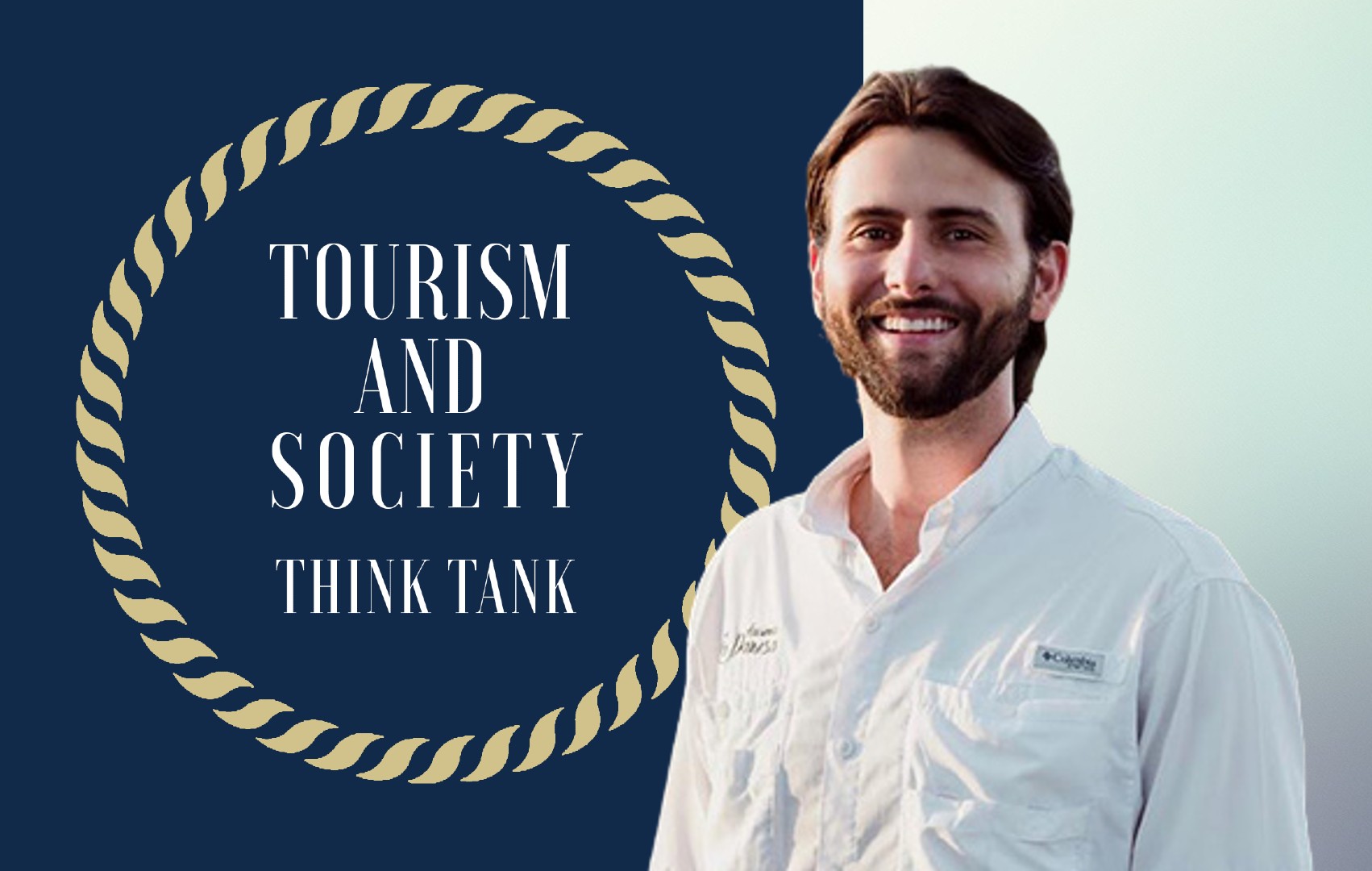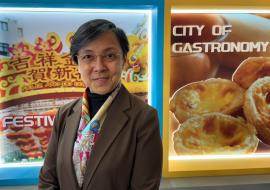Interview with Niels Olsen, Minister of Tourism of Ecuador

Today we have the honour of interviewing Niels Olsen Peet, Ecuador's Minister of Tourism, who stands out for several reasons: being the youngest Minister of Tourism in Latin America at 34 years of age; and for having the backing of the country's tourism sector.
On 24 May 2021, he was placed in this position because he has a broad academic background in tourism, as well as an important participation in the industry from the private sector, which has made him one of the leaders of tourism in the American continent in a short period of time.
Since his appointment, Mr. Olsen has stated in concrete terms the four main objectives he had in mind to reactivate tourism in the country, following the blow suffered by the pandemic:
-
Vaccination of the tourism sector
-
Promotion for the revival
-
Financial relief for the tourism sector
-
Recovery of air connectivity and (reactivation of the train).
Niels Olsen was born in the province of Guayas, where he has directed the tourism project of Hacienda La Danesa, on the Naranjito-Bucay road, a venture highlighted as a successful agrotourism model, involving the surrounding communities.
Mr. Olsen studied Business Administration and Marketing at Louisiana State University, USA, was a member of the Society of Entrepreneurs of Latin America at Stanford University, and holds a Master's degree in Sustainable Tourism from Monash University in Australia.
Dear Minister, as the person in charge of national tourism, what are the main lines of work of the tourism policies you are developing in Ecuador?
I maintain the same energy, passion, enthusiasm and goals with which I assumed this position on 24 May 2021. Although the public sector is very different from the private sector, which is where I come from, I believe that we have overcome the most important obstacles and have made very important achievements, which are the beginning of a process to take tourism in Ecuador to another level.
As an initial part of our management, we were able to address several of the private sector's demands, which were completely valid. In this ministry we are empathetic with them because for many years they have been moving their businesses forward, generating employment and injecting resources without much help from the government; I am happy to report that we have managed to work hand in hand on multiple projects to achieve joint objectives.
Listening to them, we compromised on four points that we felt were the most important and urgent in the tourism sector.
-
Vaccination:
That the tourism industry be vaccinated as a priority, and we achieved this in record time. We were the first country in Latin America to achieve this. We did not leave anyone out, receptionists, waiters, tourist transporters, guides, etc., and that generated confidence for Ecuadorians to travel around the country, and also for foreign tourists to come with peace of mind. This achievement came about thanks to the collaboration of the private sector, academia and the public sector, and became the demonstration that when we all work together we can achieve great things.
-
Financial Relief:
As we know, the tourism industry was the hardest hit by the pandemic and needed urgent respite. We included several articles in the Tax Law that apply exclusively to the tourism sector.
Tourism companies that recorded losses in 2020 and 2021 can deduct those losses from their income tax for up to ten years.
In addition, they can restructure their debts with the SRI and IEES for up to four years, with no down payment, to avoid coercive lawsuits, and to improve competitiveness we eliminated VAT for foreign tourists staying in hotels in Ecuador.
We lowered VAT from 12% to 8% on the twelve holidays of the year, as a measure to motivate Ecuadorians to get to know the country.
-
Promotion:
We managed to approve and prioritise a budget of $47.5 million to invest in promoting the country between 2022 and 2025. The promotion plan was presented to the entire tourism sector so that they are aware of the fairs in which we are going to participate, how many familiarisation and press trips we are going to make, etc. We now have public relations officers in the United States, Canada, England and in some Western European countries. In addition, we have set up a website (ecuador.travel/en/promotion) where we have published about 30 promotional activities in which we will be participating in the last four months of 2022 so that members of the tourism sector can get information and participate.
To date, Ecuador has once again been present at events in priority markets; this is absolutely positive for our industry, as we are bringing the best of Ecuador to the eyes of the world. To date, we have participated in 12 international events, including destination promotion fairs, road shows and investment attraction events.
-
Air connectivity:
We managed to eliminate the 5% tax on foreign exchange outflows for international airlines. We are signing open skies agreements with different nations and we have a new national flag carrier: Equair, which entered to compete by improving the conditions for purchasing tickets, and that is exactly what must happen to lower the cost of travel, because it is counterproductive for the government to regulate prices.
To date we have recovered 82% of international air connectivity and about 75% of domestic connectivity. But these figures will continue to increase in the coming months as we will be inaugurating new routes to Miami, Cancun, Buenos Aires, etc., so we expect to end the year with 90% recovery of international air connectivity and 80% domestic.
What does the Ecuadorian tourism industry offer to the social, economic and cultural development of the country?
Activities related to the tourism industry in Ecuador are intensive in the generation of employment, with a 6% contribution to total employment, above transport and even construction activity.
It is not only relevant in terms of internal job creation, but also occupies the 4th place in non-oil exports and, within them - according to ECB figures - it is the one with the highest inter-annual growth in the first quarter of the year 2022, with 103%. For its part, the impact of accommodation and food service activities on the economy is 2%, surpassing traditional industries such as electricity, fishing, aquaculture, and the tourism sector.
And what does Ecuador offer the international tourist that is different and unique, taking into consideration the offer of other Andean countries?
Ecuador is a privileged country due to its geographical location and offers its visitors the opportunity to visit not only the Andean area but also its 4 worlds: Coast, Andes, Galapagos and Amazon in a reduced space, with a megadiverse offer from the ecological, cultural and historical point of view, always framed in the constant search for a sustainable tourism that is environmentally friendly, socially responsible and economically inclusive.
During your current administration, what do you see as the main milestones achieved?
In terms of regulatory improvement and simplification of processes to obtain the accreditation of the Tourism Registry, significant reforms have been made that allow people who wish to carry out formal tourism activities such as accommodation, food and beverage, and operation and intermediation, to do so in the SITURIN Institutional Platform, and in less than an hour, they can obtain their Registration certificate, and proceed with the other requirements established in the current regulations. It is worth mentioning that this procedure used to take more than a month.
In terms of public policy proposals to boost the national tourism sector, we can mention the following:
Tourism Sector Plan: National planning tool that defines the work horizon for tourism until 2025.
Policy for the prioritisation of cantons and regions for tourism ZEDES: Document that identifies the cantons where it is necessary to implement tourism development poles.
Proposal for regional articulation "Caminos Andinos": the initiative through the Andean Community (CAN) seeks to jointly promote the reactivation of the tourism sector in the region (Bolivia, Colombia, Peru and Ecuador) and make the tourism offer visible, through the common axes of cultural heritage, natural heritage, gastronomy, rural and community tourism.
Regarding the promotion of our destination at the international level, we reiterate that the support of the Central Government through the prioritisation of a budget for promotion and innovation of 47 million from 2022 to 2025, is allowing us to resume our presence in national and international fairs and events, strengthening the positioning of Ecuador as a destination through new representation agencies in the prioritised and segmented markets, support to private enterprise through the organisation of road shows and virtual and face-to-face business rounds, strategic alliances with public sector entities focused on tourism, among others.
Regarding collaboration between bordering countries, do you think there is a common strategy or is this one of the weaknesses of the Andean countries?
It is essential to act in synergy; strengthening tourism in the region allows for a comprehensive experience. Many times, world travellers choose to make a tour of South America, visiting the different attractions offered by each destination.
In this sense, one of the initiatives that stands out with the countries of the region is the proposal presented within the framework of the Andean Community (CAN). On 21 October 2021, during the 154th Extraordinary Meeting of the CAN Commission, the Ministry of Tourism of Ecuador, in its capacity as President Pro Tempore, presented the "Andean Roads" initiative, with the aim of jointly promoting the reactivation of the tourism sector in the Andean Region.
In this context, two tourist routes were presented by each delegation (Bolivia, Colombia, Peru and Ecuador), with the aim of making the tourism offer of the Andean region visible, through the common axes of cultural heritage, natural heritage, gastronomy, rural and community tourism. In addition, the project was approved in the Community Initiative Fund (CIF), which finances the international promotion of the "Caminos Andinos" initiative, for USD 184,000.00. 184.000,00.
In fact, on 29 August 2022, the President of the Republic of Ecuador, Guillermo Lasso, officially handed over the Pro Tempore Presidency of the CAN to the sister Republic of Peru, with the aim of continuing with the efforts made, strengthening the promotion of the regional tourism product and generating new projects.
In your opinion, where are the key points in the relationship between the Ministry and the country's tourism industry?
One of the key points, without a doubt, has been the maintenance of an honest line of communication, as well as the monitoring of the main needs of the sector, at the national level.
The Ministry of Tourism owes its duty to the tourism industry, which is why it is essential to listen to all industry stakeholders. In this context, we maintain joint working spaces between the public and private sectors, one of these examples is the Tourism Executive Board, which is the place for resolving sectoral and inter-sectoral coordination failures that allow us to focus instruments, policies and actions for the productive and competitive improvement of the sector.
Within our approach to sustainability, we seek to prioritise the countryside and all its tourist, cultural and gastronomic offerings, which is why we are working on the "Ecuador from its Roots" programme that promotes the enhancement of these products and their presentation to tourism operators and service providers, for the consolidation and revitalisation of the existing offerings.
I have always considered that the Ministry of Tourism should be seen as a strategic ally for the industry through which it facilitates training, education, technical assistance and accompaniment processes so that tourism businessmen and entrepreneurs become increasingly competitive, resilient and innovative.
Currently, the Ministry of Tourism is developing a territorial programme called Bootcamps, which seeks to strengthen the technical knowledge of tourism service providers throughout the country. The Bootcamps are developed as 3-day practical workshops, in which beneficiaries have the opportunity to apply their knowledge in a practical and real environment. By the end of 2022, we will conduct 24 bootcamps, 1 in each province of the country, and we expect to reach more than 720 tourism service providers.
Finally, the joint construction with the private sector of a national promotion action plan aimed at priority markets, allows the development of strategic actions aimed at positioning Ecuador as a destination in a joint manner and collecting the specific needs of all sectors of the tourism industry.
Tourism and crafts are closely related. What is being done by the institution you lead?
It is essential to emphasise that tourism stimulates a whole value chain that includes 52 economic activities and crafts are part of this chain. In each holiday or local festivity, the different State portfolios promote the integration of the actors of the productive sector, taking advantage of the flow of visitors; this, in short, increases tourist spending in general.
And what about the relationship between tourism and the country's important natural heritage?
Because of its geographical location, Ecuador offers magnificent possibilities for tourism, due to its great diversity of landscapes, culture, nature, heritage and gastronomy.
Ecuador has natural heritage sites declared by UNESCO, such as:
-
Galapagos Islands (1978, 2001)
-
Sangay National Park (1983)
We cannot leave aside the cultural heritages and their direct relation with the tourist activity:
-
City of Quito (1978)
-
Historic Centre of Santa Ana de los Ríos de Cuenca (1999)
-
Qhapaq Ñan, the Andean Road System (2014).
Each one of them represents the historical value and fundamental identity of our national territory.
Tourism, environment and sustainability are very important in Ecuador. What do you think makes Ecuador's offer different from that of other countries?
Ecuador is the most megadiverse country per square kilometre and is recognised worldwide for its richness and variety in terms of flora and fauna per square metre. We are enormously fortunate to concentrate in a small territory the diversity of the planet, which is combined in the Andes Mountains, the paradisiacal coasts, mysterious and deep Amazonian jungles and a unique treasure in the world that constitutes a natural laboratory called Galapagos. All these places concentrate 10% of all the species of plants in the world.
Our country has more than 17,000 species of vascular plants or flowering plants, as indicated in the Fourth National Report for the Convention on Biological Diversity. And in the case of orchids, Ecuador has four of the five existing subfamilies on a global scale, which means more than 4,000 species that have been classified and published to date, of which 1,714 species are endemic; even the smallest orchid species in the world is found here, at 2.1 millimetres in size.
Ecuador is home to approximately 1,600 bird species inhabiting the mainland, plus a further 38 species endemic to the Galapagos Islands. Ecuador is home to a total of 350 species of reptiles and 400 species of amphibians. There are 210 species of snakes alone, ranging in size from the extremely small, 16 cm, to the gigantic anaconda, which can reach up to 6 metres in length. It is estimated that there are more than 800 species of fish in the waters of the Amazon basin region, including electric eels and piranhas.
It is estimated that in the most biodiverse areas of the Ecuadorian jungle, half a hectare can contain up to 70,000 species of insects. The number of butterfly species alone is estimated to be around 6,000. It should be taken into consideration that the total number of butterfly species in the world is around 20,000.
There are approximately 324 species of mammals, including jaguars, pumas, ocelots, wild pigs, tapirs, spectacled bears, peccaries, deer, freshwater dolphins, manatees, armadillos and 16 species of New World monkeys. About 40% of all mammals in Ecuador are bats.
In addition to the creation of the new Galapagos Marine Reserve, which adds 60,000 square kilometres to the marine protection zone, it protects the biological corridor that exists between the Galapagos Islands in Ecuador, Cocos Island in Costa Rica and other oceanic islands in neighbouring countries such as Coiba in Panama and Malpelo in Colombia. This is the result of the conservation efforts promoted by Ecological Transition, this action will allow us to protect the great biodiversity of the ocean and promote sustainable tourism in the Galapagos.
The volcanoes and beautiful mountains in your country mean that tourists arriving in your country have a different tourist interpretation of the meaning we have of nature. Do you think this idea is well identified in international promotion?
Ecuador seeks to promote each region of the country, which has unique places to discover. Undoubtedly, our natural areas are a great attraction for national and international travellers, who seek to visit these wonderful places that offer multiple experiences.
We can not only talk about volcanoes and mountains, we also have natural parks, protected areas, lakes, trails, forests, jungles, and much more is what nature lovers will find in our country.
Ecuador has more than 60 mountains and peaks for the practice of: canopy, paragliding, climbing, mountain biking and low, medium and high mountain trekking. More than 950 km of mountain range divided into two branches: western and eastern. ECUADOR is a journey where you can feel the sky closer to you.
This is precisely what we have projected through our participation in the international fairs in which we have participated, an example of this was the Global Bird Fair in the United Kingdom, a fair specialised in birdwatching, in which Ecuador had an outstanding participation.
Let's talk about the digitalisation of the tourism industry, what plans is your Ministry developing?
As mentioned, one of the key factors in our administration has been the development and improvement of the SITURIN institutional platform, which allows tourism service providers to obtain Tourism Registration accreditation in less than an hour.
Through our Undersecretariat for Competitiveness and Tourism Development, we have formulated a digitalisation plan whose objective is to "Promote the economic reactivation of tourism MSMEs through e-commerce and digital tools that contribute to competitiveness and exposure in the global digital market".
The plan includes: a component of induction and strengthening of knowledge through virtual media aimed at the tourism industry, described as follows:
-
Initial modules: with digital transformation, innovation and quality (to be launched in Sept 2022).
-
Basic modules: with social media and digital SIGO.
-
Intermediate modules: with google ads - analytics; Facebook business; and, Whatsapp business.
-
Advanced modules: CRM and INBOUND.
In addition, next month we will sign an agreement with CITEC to strengthen and develop cooperation in the framework of the digital transformation of business ideas, entrepreneurship and tourism companies, in order to stimulate the application of technology, innovation and quality in all possible areas of the tourism business.
When you took office, you spoke about your objectives for your mandate as minister. What is innovative about your promotion proposal for the revival of the tourism industry?
In the post-pandemic world, it is undeniable that the digitalisation of the promotion of a destination plays a key role. From this perspective, innovative initiatives have been implemented through which influencers and content creators are linked to the permanent positioning of Ecuador as a destination on social networks through the ECUADOR FILM RESIDENCY programme.
Also, our VISA NÓMADA project, which invites workers from all over the world to live the experience of travelling around Ecuadorian territory while continuing to work remotely.
You also talked about financial aid to the sector, what have you proposed and what have been the results?
Financial aid measures for the tourism sector were established in the Organic Law for Economic Development and Fiscal Sustainability after the COVID 19 pandemic, in which the following benefits were established:
-
Compensation of tax losses incurred in the years 2020 and 2021, with taxable profits to be obtained in subsequent fiscal periods up to 100% for a maximum of 10 years.
-
Payment facilities for tax obligations and with the Ecuadorian Social Security Institute, for a maximum of 48 months, in which case the remission of interest, fines and surcharges on tax obligations with the Internal Revenue Service will be applied, with maturity during fiscal years 2020 and 2021.
In addition, a solution of obligations for credits with payment problems for those tourism companies that maintain credit operations with public banks, for which the option of restructuring the outstanding credit with a rate of 7%, lower than originally agreed, with no down payment and with up to 5 years of grace was offered.
In addition, we are working with public banks, particularly with BanEcuador, to develop a credit product for the tourism sector at a rate of 5%, with a 1-year grace period and up to 10 years for repayment, with amounts of up to USD 20,000, which will allow the reactivation of the tourism sector. 20 thousand dollars that will allow the reactivation of micro and small tourism enterprises.
Regarding connectivity, train and mainly air connectivity, are the results as expected?
After 15 months since we began our administration, the percentages both nationally and internationally have increased compared to 2021 and we are gradually approaching the figures we had in 2019, before the suspension of air operations:
Internationally
-
270 international direct weekly frequencies (80% recovery)
Domestically
-
275 weekly domestic frequencies (72% recovery)
The projection for December 2022 is to reach 90% in international frequencies and 80% in domestic frequencies.
With reference to the train, it is important to indicate that this Ministry is part of the working groups of the National Railway System formed by the Ministry of Transport and Public Works, Ministry of Culture and Heritage, Ministry of Economy and Finance, EMCO, among others, in order to establish inter-institutional actions for the reactivation of the railway, specifically two sections: Alausí - Simbambe - Alausí; and El Tambo.
In this sense, the Ministry of Tourism is generating information related to:
-
Demand projection for the El Tambo and Alausí sections.
-
Identification of tourist attractions and products in the aforementioned stretches.
-
Identification of possible tour operators for each section.
-
Articulation with GADs and training in order to strengthen capacities to determine tourism products.
Finally, Mr. Minister, as tourists, what do you consider essential to visit or do on our trip to Ecuador?
This is one of the most complex questions, because Ecuador is full of incredible places, not only the most internationally known places such as the Galapagos Islands, Quito, Guayaquil, so I will talk about several destinations:
Trekking around the Quilotoa Lagoon: Unreal, this is the journey around this crater, just 3 hours south of Quito, where you can find a view worthy of being kept in your memories. This turquoise water lagoon, embedded in the crater of the active volcano of the same name, is in itself a natural attraction that calls for contemplation and tranquillity, where the wind is a constant ally during the journey. The weather can change suddenly, we recommend adequate food and hydration.
Trekking to Laguna Amarilla - El Altar - Chimborazo: El Altar or Capac Urcu, is an extinct volcano that erupted centuries ago acquiring a horseshoe shape with four peaks: Arzobispo, Monja Mayor, Los Frailes and Tabernáculo. It is compulsory to hire a tour guide. The route starts from the Hacienda Releche on horseback or on foot with rubber boots, passing through different types of Andean moorland, hopefully we will be able to see condors and hawks flying until we reach the Collanes Refuge, we will camp here and in two hours you will arrive at the yellow lagoon.
Trekking from the Guagua to the Rucu Pichincha: One of the best alternatives to get to know the Pichincha massif, the route is through moorlands, rocks, sandbanks and its three elevations. The route starts at the Guagua Pichincha refuge up to its summit, from where you can appreciate the crater and its fumaroles, passing by rock walls, then descends to border the slopes of the Padre Enchanted and ends by ascending to the summit of the Rucu Pichincha at Cruz Loma where you can take the cable car to Quito.
Mojanda Lagoons: The lagoons are located at the foot of the Fuya Fuya hill, on the provincial border between the provinces of Pichincha and Imbabura. This complex is made up of three lagoons, the first and biggest one Caricocha or male lagoon, of volcanic origin, the following two lagoons are of smaller surface, Huarmicocha or female lagoon and Yanacocha or black lagoon.
Lagunas del Cuyabeno - Sucumbíos: It is a lake complex located in the northern Ecuadorian Amazon that is composed of 14 lagoons and forms the largest wetland in the Ecuadorian Amazon. These flooded forests are the territory of dolphins, manatees, caimans, anacondas and otters, and the guarango de agua, the most unique tree in the reserve.
The reserve is also considered one of the most culturally diverse protected areas in the Ecuadorian Amazon. It is home to Siona, Secoya, Cofán, Kichwa and Shuar indigenous communities.
Laguna de los Compadres - Loja: The Compadres Lagoons are located in the Podocarpus National Park and offer an incredible landscape that has been formed from ancient glaciers. The lagoons are located in the central Andean mountain range, at the Sabanilla junction, at 3000 m above sea level; there are about 136 lagoons and they are home to the most important water resource of the Podocarpus.
Important South Amazonian rivers are born in this zone, such as: San Francisco, Sabanilla, Bombuscaro, Jamboé, Shaimi, Nangaritza, San Luís, Numbala, among others.
Imbabura Geopark and its lagoons:
San Pablo: very close to the town of Otavalo; it is a lake of great scenic beauty located at the foot of the Imbabura volcano. There are some high quality tourist ventures on the shores of the lake and you can also enjoy water activities such as kayaking, boat rides, jet skiing, buoys, water skiing, among others.
Cuicocha: Located in the Cotacachi Cayapas Ecological Reserve, it is a caldera and in certain parts of the lake you can still observe some volcanic activity; it is located at the foot of the Cotacachi volcano and you can do activities such as diving, boat rides, landscaping, photography, among other activities. In the centre of the lagoon there are two islets.
Yahuarcocha: The lagoon is located a few kilometres from the city of Ibarra and its surroundings have been the scene of great automobile races. In the zone there is a varied gastronomic offer and some lodging enterprises. In the lagoon you can do activities such as camping, photography, landscaping, and boat trips, among others.
Lakes of Atillo and Ozogoche: In the province of Chimborazo there is an impressive lake system formed by 45 lakes and lagoons such as Ozogoche, La Negra, Cuyug, and Atillo, which are part of the Sangay National Park.
The lagoons are deep, cold, with a striking dark blue colour, the climate of the site is cold, characteristic of a paramo ecosystem, and they are located between 3200 and 3600 metres above sea level.
In the Atillo lagoon, there is an island to the north with Andean forest vegetation, where the flora and fauna of the Andean forest can be appreciated.
In the lagoons of Ozogoche, one of the surprising aspects is the observation of the natural phenomenon of the migratory birds called "cuvivis", that arrive to the lagoons to take their lives, falling into the waters of the lagoons, this natural event can be appreciated in the month of September.
Quilotoa and Limpiopungo Lagoon: In Cotopaxi there are impressive tourist attractions to visit such as the Cotopaxi volcano and the Quilotoa Lagoon.
The Quilotoa is a volcano that collapsed more than 800 years ago, inside its crater a lagoon has formed, its water has bluish green tones when it receives the impact of sunlight. On the other hand, in the Quilotoa lagoon you can hike around the caldera, which is approximately 9 km long, and enjoy the spectacular scenery.
The Limpiopungo lagoon is located in the Cotopaxi National Park, which lies between two volcanoes, Rumiñahui and Cotopaxi, and is one of the obligatory stops if you visit the protected area.














